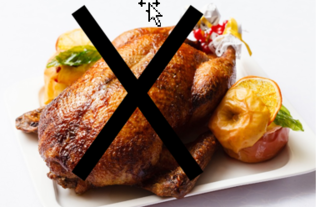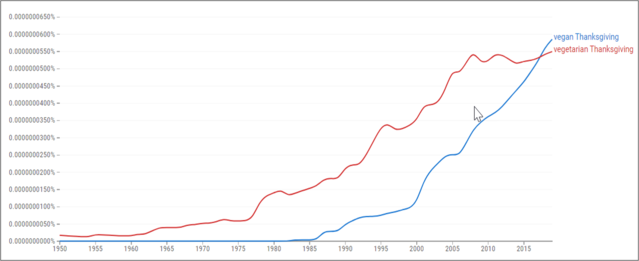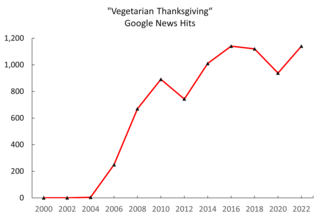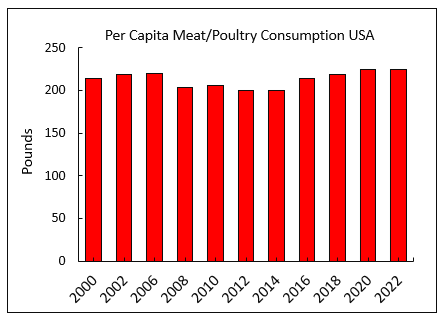Media
The Meatless Thanksgiving Dinner Paradox
Vegetarianism in the U.S. is on the rise, but meat consumption has not changed.
Posted November 22, 2022 Reviewed by Lybi Ma
Key points
- Americans will eat more plant-based Thanksgiving dinners this year.
- The percentage of Americans who do not eat meat has doubled in the past two decades.
- Per capita meat consumption in the U.S., though, has not changed in decades and remains among the highest in the world.

On Thanksgiving Day, my vegetarian friend Cathy Nieman and her family will dine on Gardein Plant-Based Turk’y Cutlets, a vegan alternative to a Butterball. Alexander Hamilton would not have approved. He is reputed to have proclaimed, “No citizen of the U.S. shall refrain from turkey on Thanksgiving Day.”
Americans seem to have taken him up on this dictate. According to the National Turkey Federation, Americans eat nearly 50 million turkeys each year on Thanksgiving day. But for a couple of reasons, fewer turkeys will die for our dining pleasure in 2022. One is that the price of turkey jumped 25 percent in the last year. This spike in prices is due to both inflation and an outbreak of avian flu that has killed more than 7 million birds.
But there is another reason turkeys will grace fewer tables on Thanksgiving in 2022—changing American attitudes toward meat. The idea of a meatless Thanksgiving dinner has been gaining traction for several decades. I used Google’s Ngram Viewer search engine to examine shifts in the relative frequency that the terms vegan Thanksgiving and vegetarian Thanksgiving appeared in American books between 1950 and 2019. As you can see in this graph, interest in vegetarian Thanksgivings began to increase steadily after the publication of Peter Singer’s influential book Animal Liberation in 1975. About a decade later, this was followed by an uptick in interest in vegan Thanksgiving dinners.

But the idea of meatless Thanksgiving dinners took off about 20 years ago. For example, according to a Google News internet search I conducted, media coverage of a vegetarian Thanksgiving jumped 350-fold between 2004 to 2022.

The Meatless Thanksgiving Paradox?
You might think that this huge spike in media coverage of plant-based Thanksgiving dinners is simply a reflection of a similarly large increase in the number of American vegetarians and vegans. But this is not the case. To assess the number of vegans and vegetarians in the U.S., the Vegetarian Resources Group regularly commissions surveys on the diets of representative samples of Americans. Their data indicate that the percentage of Americans who do not eat meat has doubled over the past 20 years—from 2.8 percent in 2003 to 6 percent in 2022. But while impressive, this rate of increase pales in comparison with the 3000 percent jump in media internet coverage of vegetarian Thanksgiving dinners.
But while the visibility of vegetarian and vegan lifestyles on America’s culinary landscape has skyrocketed, the actual amount of animal flesh Americans consume has not budged. Indeed, according to data from the National Chicken Association, in 2022, the U.S. set a new record—224 pounds of red meat and poultry per person, among the highest meat consumption in the world.

How do we make sense of both increased interest in meatless holiday dinners and the doubling of the number of Americans who are vegetarians and vegans, and, yet per capita consumption of meat in the U.S. has remained stable—or even gone up—over the past couple of decades?
The rise of interest in meat-less Thanksgiving dinners could be due to the growing number of Americans who identify as “flexitarians” or “reducetarians.” Flexitarians and reducetarians are concerned about the negative health, environmental, and animal welfare impact of meat eating. For a variety of reasons, however, they don’t completely give up the consumption of animal protein. (See 84 percent of Vegetarians and Vegetarians Return to Meat.) One recent survey found that nearly half of Americans between the ages of 24 and 39 identified their diet as flexitarian.
You are probably familiar with some of the campaign slogans to encourage people to cut back on meat, “Meatless Mondays” or the Eat Vegan Before Six Diet or Vegan January. Not surprisingly, many meat reducers are drawn to the idea of Thanksgiving dinner sans the turkey. The rapid rise in the number of Americans who claim to be meat reducers might explain the increased visibility of meatless Thanksgiving dinners, but it does not explain the fact that meat consumption has not dropped in the U.S. over the last 20 years.
The paradox is that the collective desire of Americans to eat animals has not declined at all despite an increase in vegetarianism and veganism and an impressive jump in sales of plant-based foods. (There are now three vegan restaurants within 15 miles of my house in the mountains of North Carolina, including Plant, one of the top-rated vegan eateries in the United States.)
When I described this to my wife, Mary Jean was puzzled. “That does not make sense,” she said.
“Beats me,” I said. “What should we have for Thanksgiving dinner?”


